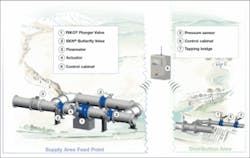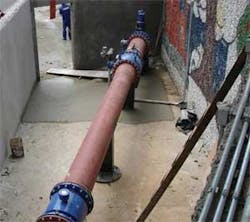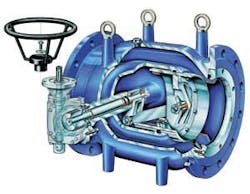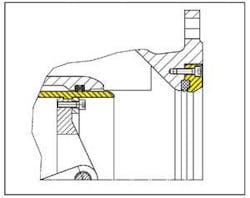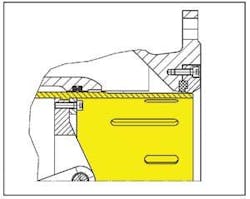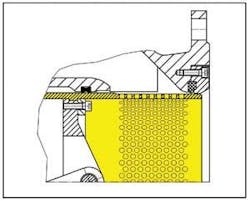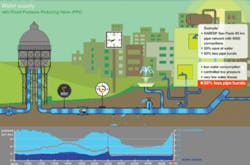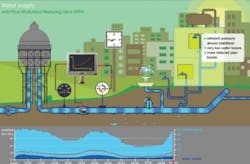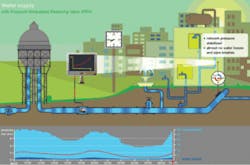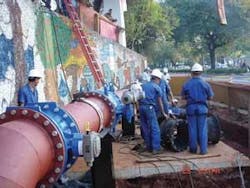Reducing Water Losses by Intelligent Pressure Management
By Peter Oppinger
How to reduce non-revenue water and pipe bursts via pressure reducing valves and distribution network management is outlined here by German valve maker VAG, with a public-private partnership project from São Paulo, Brazil, to illustrate it
Leaks in water pipes and leaking valves in urban water distribution systems and pipeline networks, mainly in developing and threshold countries, are the reasons for water losses of up to 50% in relation to the water quantity being produced in the water works.
General Problem
To overcome this problem, more often investments in the water sector are made first to increase production — instead of to generate programs to reduce water losses.
To change this way of thinking, the most economic — and ecological — solution is to reduce water losses in the distribution systems and not permanently increase water production. Whilst production capacities are being increased, the structure of the pipeline system, originally designed for much smaller output volumes, remains the same. In particular, the valves which have to regulate the flows and pressures to maintain a constant supply of potable water cannot do their job in an adequate way. If those valves cannot be controlled exactly, this will lead to high pressure differences in the piping system, pipe bursts, and, ultimately, a complete collapse of the entire distribution system.
This is the task for regulating and control valves, which will control flows and pressures, or just open and close water distribution pipelines.
Finding Solutions
With an innovative concept VAG-Armaturen GmbH offers three different approaches of employing its intelligent VAG Pressure Management System to reduce water loss and pipe bursts. The systematic reduction of pressure in the main water supply system enables the utilities to reduce water loss to sustainable economic levels, as well as allows them to either scale back investment in treatment works and their operation or redirect it to other improvements or future needs.
Method — A control device (plunger valve) and a pressure sensor together with a flow meter are installed at the supply area’s feed point. A programmable logic controller (PLC) records, processes and archives the measured sensor data needed to control the plunger valve. Depending on the supply system’s topography and consumption, the valve is moved into the position that optimally reduces the supply pressure. Reducing the supply pressure reduces the amount of lost water. A positive side effect is reducing the supply pressure reduces risk of new leaks occurring in the supply system.
Monitoring — The feeding volume and supply pressure are constantly monitored and available for the customers review and further analysis. Secure cellular technology is used to transfer the data to a PC that is connected to the internet. A software programme enables the utility to follow the valve’s operation online, making laborious journeys to remote supply points a thing of the past. Failures are sent directly to the responsible service team of the utilities in the form of an SMS alert. Their service personnel is only notified when they’re needed, saving them time and of course additionally expense. A local control cabinet enables the utilities to monitor the pressure and operate the valves by hand. All of the important operating information can be viewed on a text display. Control parameters can be viewed and changed on site without any assistance from VAG.
Network Management — The system solution from VAG consists of several components (see Figure 1). The picture displays a by-pass solution that enables a water utility to mechanically override the control device at any time. At the system’s heart is a plunger valve. Based on local power supply in the utility’s network system, the control valve is powered by a DC, AC, or three-phase actuator. A flow meter continuously records actual water volume supplied to the distribution area. The pressure sensor behind the by-pass is used as the actual value for the pressure reduction function of the PLC. Status information about the volume taken, measured pressure and the actuator converge here.
As part of the system, each customer receives a plunger valve, pressure sensor, flow meter, a programmed controller and, optionally, a cellular modem to transfer data to the customers central control station. A training course for the utility’s engineers also can be part of the package. There’s a certain amount of civil works required for installation. Compared to the large savings potential, however, the initial investment is very small.
Taking the Plunge
The VAG RIKO® plunger valve precisely regulates pressure in a piping system and guarantees a constant supply of water at any time or condition in coordination with both flow rate and network pressure. Previously, only the term of needle valve was used for valves having a controlling function. Today, the term plunger valve is common due to design features shown in Figure 2:
- The cross-section of the flow is annular in each position of the valve
- The axially movable closing device is shaped like a piston or a plunger
VAG redesigned the existing plunger valve already established in the market for decades. Its plunger valve is available in nominal widths from DN 150 up to DN 1600 and in pressures ranging from PN 10 up to PN 40. The compact and single-piece body is made of high quality ductile cast iron (GGG-40) with an inner body connected to the outer body by cast ribs. On the upstream side, the inner body has a spherical shape and the shape of the annular space results in a continuous narrowing towards the seat on the downstream side. Depending on hydraulic conditions, there are different outlet parts available (see Figure 3). The cross-section is reduced in its flow, which is symmetrical to the axis, until the fully closed position of the piston is reached and the valve is absolutely drop-tight. The piston or plunger is normally made of stainless steel and is operated by an internal piston-drive made of ductile cast iron or stainless steel. An essential advantage of the new plunger valve is its piston guiding which is made of welded bronze. The piston-drive is connected by a stainless steel shaft to a gear box assembled to a connecting flange on the outside of the body. New sealing systems for pistons, shaft bearings and seats guaranty a good corrosion protection and high performance combined with a long life time.
Plunger valves are designed to fulfill special control functions in the water supply systems. Unlike butterfly or gate valves which assume only shut-off functions in pipeline systems, plunger valves meet the special requirements of regulating operations. These valves can be used for potable water up to 50°C (122°F). Due to the linear regulating characteristic, these guarantee best cavitation behaviour with lowest friction-loss at the same time.
null
null
Modes of Operation
The VAG plunger valve can reduce the pressure in the customers’ network by using the following modes:
- Time-based modulation
- Flow- or demand-based modulation
- Remote node-based modulation
Each mode of operation offers different control characteristics and benefits which may be selected to meet the budget and engineering requirements as described in the following text:
1. Time-based modulation — This method is achieved by using a controller with an internal timer to change the set point of the fixed outlet control (see Figure 4). Control is affected in time-bands in accordance with the demand profiles. The mode is very effective for areas with stable demand profiles and head loss and is usually used where cost is an issue, but a more proactive pressure management is desired, for example where night time pressure is to be reduced for a number of hours to reduce the effects of leakage. The step before the time-based modulation is the so-called fixed outlet modulation, which is the most basic control and which is achieved by simply modulating the valve to provide a steady outlet pressure (set point) as system flow demands change, and which smart plunger valves can of course handle as well.
2. Flow- or demand-based modulation — More water can be saved and more pipe bursts avoided when the pressure is following the demand cycle during the whole day, week, month and year (see Figure 5). A flow meter in the main supply pipeline recognizes current demand for water in the network. This value is sent to a computer, where an evaluated curve specifically for this network is stored. The curve shows the minimum pressure necessary to maintain the related flow rate. This method has in the past proven to be the best type of control for areas with changing conditions, head loss, fire flow requirements and the need for proactive control. As demand is reduced primarily at night, pressures are reduced then — and, when demands peak, higher pressures can be applied to the district. The effect is an efficient control of pressure and water losses. As pressures are smoothed out at the weaker extremities of the system, the number of new pipe breaks also is reduced.
3. Remote node-based modulation — With this mode the pressure will be measured directly in the network at a critical point (see Figure 6). The signal is sent via a wireless connection to the control valve. This type of control is probably the most proactive and is affected by connecting a remote pressure sensor to the valve controller, by means of radio or GSM — global system for mobile communication. A remote sensor is usually placed at a critical point in the district and the controller set to change pressure at the valve to consistently maintain the desired pressure in the network system. As with the flow-based modulation discussed above, this mode also smooths system pressure at the weaker extremities and has the added effect of reducing the number of new pipe breaks.
A Case Study
The water consumption in the metropolitan area of São Paulo is continuously increasing. Today, for the local water suppliers — namely state-owned Companhia de Saneamento Básico do Estado de São Paulo (SABESP) — it’s a challenge to meet the demand of the over 17 million people of the city and ensure a constant supply of potable water in sufficient quantities. Despite the quality service provided by SABESP, it’s possible to experience periods of rotational supply caused by lack of resource during a dry period. One reason for lack of water supply is the high volume of water losses that occur during operation due to leakage at critical points like mains and fittings. If the pressure can be managed effectively, then water loss will be reduced.
The VAG task was to combat head loss and to apply pressure to the pipeline system when required and reduce pressure off the pipeline system when legitimate demand is at it lowest. This was achieved by installation of an intelligent pressure reducing valve operating on a remote node modulation basis.
Supported by the German government and in cooperation with the DEG — Deutsche Investitions- und Entwicklungsgesellschaft GmbH, one of the largest European development finance institutions — and SABESP, VAG-Armaturen GmbH started the Public-Private Partnership (PPP) Project for Sustainable Water and Natural Resources Management in São Paulo in March 2004 and August 2005. VAG and SABESP installed in a pilot site in the District of Santo Amaro with a population of about 30,000 people and 80 km of distribution pipes consisting of a highly sophisticated water loss reduction system that included pressure regulating valves, control panels, telemetry installations and the supporting software.
Conclusion
This pilot site has demonstrated that modulated pressure management significantly reduces both the volume of water loss and the frequency of new pipe breaks occurring. For the Santo Amaro district this means a reduction of up to 50% in new pipe breaks and 30% more volume, which is sufficient to supply an additional 8,000 people with potable water. This is of particular significance in a fast growing metropolis like São Paulo, and also important for other municipalities all over the world.
Author’s Note:
Peter Oppinger is head of marketing at VAG-Armaturen GmbH, which is based in Mannheim, Germany. Contact: +49 621 749-2106, [email protected] or www.vag-armaturen.com

